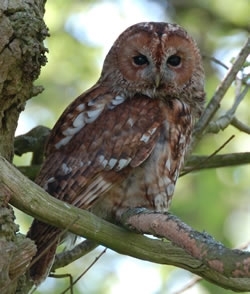 The Tawny owl
The Tawny owl
The Tawny owl is our most common and widespread owl, being found across the whole Britain, but not at all in Ireland. It is also absent from the Northern Isles and rather bizarrely, from the Isle of Wight too, even though the owls that live along the coast of Hampshire can quite clearly see the island! I imagine it would only take them a matter of minutes to fly across!
The Tawny owl is perhaps best known for its distinctive hooting call that seems to accompany all scary films, the moment anyone steps outside! Interestingly, the “Kewick” call is usually made by the female and the famous Hoo, hoo-hoo-hoo is only ever made by the answering male.
The tawny owl is really a bird of wooded landscapes including towns, as long as there are plenty of mature trees around. In the countryside they largely feed on small mammals, but also birds, bats amphibians and even earthworms. In towns they tend to take a higher proportion of birds, plucked from there roosting sites by sharp talons.
These sharp claws will also be used to good effect when protecting the nest site, especially when two or three downy youngsters are sitting in the tree hole or nest box. In fact the pioneering wildlife photographer, Eric Hoskings, (a childhood hero of mine) actually lost an eye trying to film owlets in a nest site, when he was ferociously attacked by an irate parent.
Accordingly, nowadays, bird ringers will kit themselves out with protective clothing, goggles and even a crash helmet when planning to ring young tawny owls!
What ringing has shown is that these owls are incredibly sedentary, with the average distance flown between being ringed and being recovered, of only 1km.
As the Tawny owl is a nocturnal species, it is heard far more than it is seen and accordingly it has to be surveyed specifically to find out its status, as ordinary day time surveys rarely account for any, unless they happen to be flushed from a conifer or ivy clad tree, where they are spending the day light hours.
The tawny owl is an early nester and lays 2-3 large, white, round eggs in late February and March and incubates them for 30 days. The nestlings will eventually fledge after 35-39 days, but remain dependent on their parents for two to three months afterwards.
The reason a tawny owl has such a rounded head with facial disks around each eye, is to allow the owl to direct sound waves to its ears. Its ears are hidden behind the feathers on either side of its head, and are slightly out of alignment with each other, giving the bird its exceptional directional hearing, while allowing it to pinpoint prey very precisely.
If you have never seen a Tawny owl close up in the wild, and would like to, then here is a little tip. On wet and windy nights, Tawnies will often resort to sitting on over-hanging tree branches above a minor road or lane which runs through a wooded area. I imagine that this form of hunting – predominantly using their eyes to spot a small mammal crossing the road - is adopted as their amazing hearing is somewhat limited by the noise that the wind and rain is making.
If you travel slowly along in a car late at night, once the other traffic has died away, you have a good chance of picking up an owl sitting patiently on its branch. Using a high powered torch, it might even let you slowly get out of the car and take a good look, or even a photograph.
One bit of advice though, if you plan to do this. It might be sensible to have a “plan B” if the police turn up and ask you what you are up to. “Watching Tawny owls”, on a wet, windy and thoroughly miserable night, just might not cut the mustard with them!!
Peter Thompson
Advisory
Read more from Peter Thompson at his blog.

Download Peter Thompson's essential 26-page book, featuring beautiful photography and detailed profiles of Britain's wildlife
Download FREE >